Stargazing

|
Gemini the Twins |

|
- We now return to the Dipper and follow the
two stars diagonally across the cup southwest to the star Castor. This is
part of the Zodiac Constellation Gemini the twins. The two brightest stars
are Pollux, to the left, and Castor, to the right. {Trace out Gemini}.
At this time of the year, with Leo straight up overhead, the constellation
Gemini stands above the western horizon, towering majestically, with the
pentangle figure of Auriga to the right and the tiny but bright Canis Minor
to the left, in very impressive fashion. Well, I'm impressed.
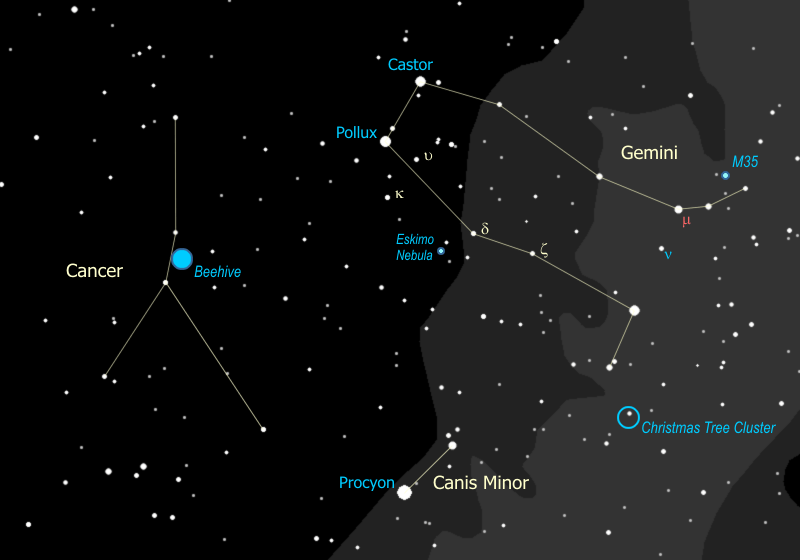
- That really bright star right next to Gemini is Procyon, the "Little Dog Star"
a mere 12 light years away, and belongs to the constellation Canis Minor, the
Little Dog, which is all of those two stars right there {Point out Canis Minor}.
The little dog belongs to Orion the great hunter, as does the Big Dog.
- The discovery of a planet orbiting Pollux in 2006 makes it one of the few
naked-eye stars known to have a planet. The planet
is at least twice the size of Jupiter and has an orbit about the same size
as Mars has around our sun. Even when Pollux was a younger star, at twice
the mass of our sun it was 10 times as bright, so even a small moon around
this planet would have been subjected to four times the intensity of radiation
that we are. Now, though, Pollux is entering the burn-out phases of a star
and has expanded, putting out 32 times the brilliance of our sun. So... not
likely there's anyone living there. We can't see the planet
in our telescope from 30-something light-years away, but we can see something
else...
- If we get Castor in the telescope at high magnification you can see it as a
double star. In reality, each of those stars is a double, too close to see
in our telescope, and then there is another, third (very faint) star that is
also a part of the system which is ALSO a double. So while we can see two
stars (at best) in our telescope, Castor is actually a SIX STAR SYSTEM, about
50 light years away.
- Down by the foot of Castor (the twin), is the open cluster M35,
a pretty darn good cluster either in binoculars or in the telescope. If we
have a clear, dark night you may be able to spot it with your eyes alone.
This is a true "galactic cluster", meaning a group of stars all born out of
the same cloud of gas. Sometimes these are called "open clusters". This
cluster is about 3,000 light years away and if you look carefully in a
telescope, you can see another cluster right next to it... that one is about
16,000 light years or nearly six times as far away.
- Since they're twins Pollux gets to have a cool cluster down by his foot too.
If you look off the tip of the foot of Pollux you will see a line of three
stars pointing to the southwest, toward Orion's belt. Put the binoculars on
the first of those three stars (closest to Pollux's foot) and you will see
the Christmas tree cluster. The star you saw is the base of the tree, and
the rest of the tree is hanging upside down from the base. Photographs of
that region show a fascinating complex of gas clouds (nebulae) around those
stars.
M35 is easy to see in binoculars The Christmas Tree is upside down (North is up) 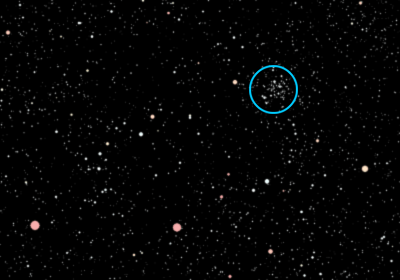
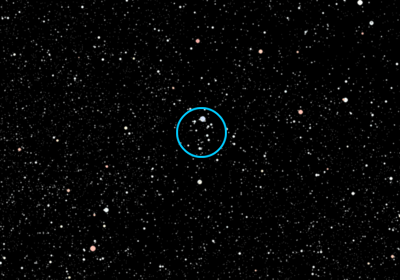
- If we follow the line from Pollux' foot toward Pollux the star, you come
across the star δ Geminorum. Next to that star
there is a small triangle of stars, {point out 56, 61, & 63 Geminorum} and
that's where we are moving the telescope next. When you look in the eyepiece
you'll see a faint star and something else... a little fuzzy spot. The fuzzy
spot is actually a star like the one next to it, with one small difference...
the star has blown itself apart! This little puff is known as the Eskimo
Nebula, also called the Clown Face Nebula. If we have a big enough telescope
you can see what's left the star at the center, a once mighty star that is
now a white dwarf. With a really good telescope we can see the Clown's (or
Eskimo's) face, with the star at the center making a clown's nose for us.
Eskimo in Telescope - can you see his face? What you're looking at (courtesy the Hubble Telescope) 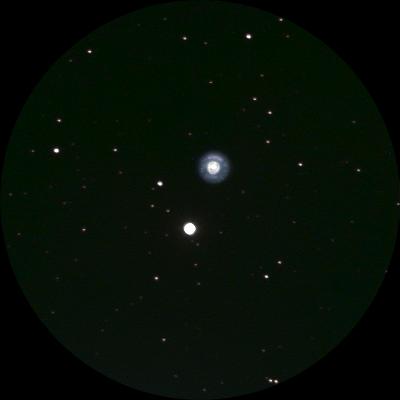
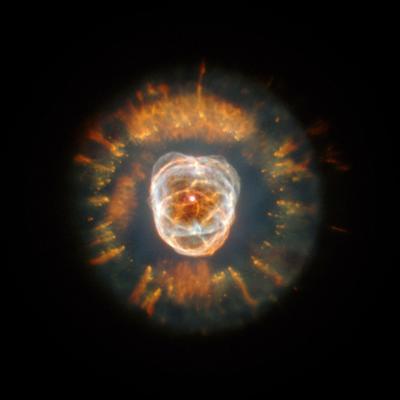
This is called a "planetary nebula", because the disk shape suggested the look of a planet to early astronomers. In fact it has nothing to do with planets at all. This is what's left of a red giant star which, a couple thousand years ago, did what all red giants eventually do. When the fuel at the core runs so low that the nuclear reactions can no longer hold up the weight of the star, it all collapses in to the center, which in turn raises the temperature so high that the star blows off its outer envelope of gases, losing much of its mass. This exposes the core to outer space, or, more accurately, exposes outer space to the core. The intense radiation from the white-hot core causes the expanding shell of gas to light up like a neon light, and voila -- the faintly glowing disk that you see here. That little disk is about 3,000 light years away and 3 light years across - the diameter of it would reach nearly from here to Alpha Centauri.
I once heard planetary nebulae described as the wreaths that Nature places around dying stars.
- I called Gemini a Zodiac constellation. What is a "Zodiac"
constellation?
As the earth goes around the sun, this motion means that every day we look back at the sun in a slightly different direction, with different stars behind it. The sun appears to move through the constellations. Theoretically there are twelve constellations through which the sun moves, one per month, and these are the Zodiac constellations. In reality there is a 13th constellation through which the sun passes (technically at least) and it gets no credit for being in the Zodiac - Ophiuchus. Because the path of the sun is also the plane of our solar system, the planets are also found on or very close to this path as well, so the line along which the sun travels has its own special name - it's called the "ecliptic".
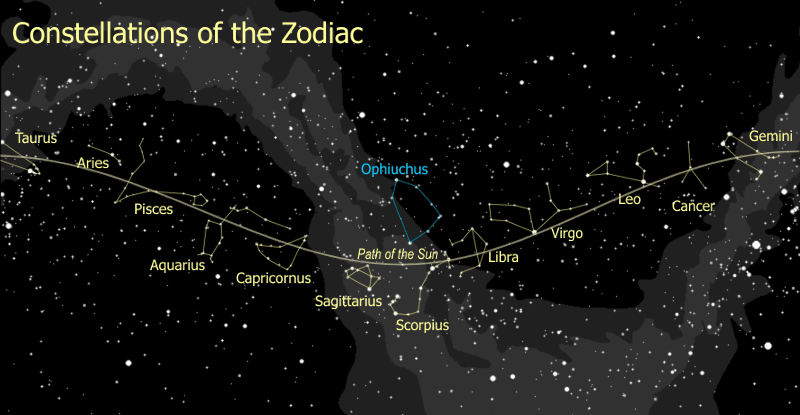
- So Gemini is one Zodiac sign and those bright stars there
are Leo the Lion, which we will explore shortly. Between these two bold and
brilliant Zodiac constellations is yet another Zodiac sign -- seemingly shy
and trying to hide between the other two -- the ever so faint Crab with the
unfortunate name of "Cancer". {Trace out Cancer the Crab}
My real target here is the Beehive, and in some cases I
don't bother with Cancer at all -- I simply tell the group to look halfway
between the bright stars of Leo and the bright stars of Gemini -- in the
center of the dark region is a faint fuzzy spot. Most people will see it
right away.
- It's so unremarkable I wouldn't even bother showing you this constellation,
except for one thing... the Beehive. If you look very carefully at
the center of the crab, you will see a faint hazy patch. Now look at that
hazy patch through the binoculars. Wow, eh? That's the Beehive Cluster,
about 500 light years away, six times closer than M35 is.
The Beehive is so big you can see it just by looking 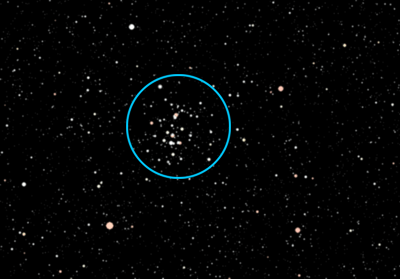
 |
 |
 |
| Back to Auriga | Go to Spring Index | On to Hydra |
Questions
Your questions and comments regarding the Stargazing section are welcome.
You can e-mail the author, Randy Culp for inquiries,
suggestions, new ideas or just to chat.
Updated 18 July 2023
